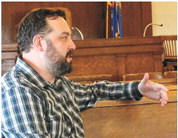TIF task force idea barely makes it out of committee
Despite fears that the county board will reject the idea of another task force, a Marathon County committee is recommending creation of a group that will study the impact of TIF districts on government finances and make policy suggestions based on its findings.
At its May 23 meeting, the Human Resources, Finance and Property (HRFP) Committee narrowly voted to advance the task force idea to two other committees and eventually the full county board. The vote was 4-3, with supervisors John Robinson, Alyson Leahy, Gayle Marshall and Kurt Gibbs voting for it, and Kody Hart, Ann Lemmer and Yee Leng Xiong voting no.
The proposal comes less than a month after a similar request for an energy savings task force was defeated when it failed to earn a two-thirds majority vote from the full board. In that case, supervisors voted 19-14 to approve the task force, falling three votes shy of the threshold needed to create one.
During debate, a couple of supervisors said they liked the idea of the county looking for ways to cut spending on energy consumption but disagreed with the notion that a new task force was needed to address the issue.
Supervisor Hart brought this up during the HRFP’s discussion last week about the proposed TIF task force, casting doubt on whether the proposal will ultimately be adopted.
“I don’t believe that a task force will make it through the county board with a two-thirds majority,” he said. “Because of that, I will oppose this task force through the committee, but I would support it if does make it to the full board.”
HRFP members have long discussed the need to examine the budgetary impacts of tax-incremental financing (TIF) on the county and its taxpayers.
TIF districts are designated areas within municipalities where the property taxes generated by any new developments are used exclusively to promote growth within the district, rather than being distributed to the county, school district and technical school system. Municipal officials use TIF tax dollars to offer financial incentives to private developers and pay for infrastructure that benefits new developments, which may not have been built without assistance.
However, TIF districts also deprive other units of government, including the county, of additional tax revenue for as much as 20 years or more, depending on the lifespan of each district. Nearly $1.2 billion worth of property in Marathon County is currently off-limits to traditional taxation because it is located within TIF districts.
According to the proposal passed by the committee, the task force would consist of nine members, including five county board supervisors, one elected official each from a township and a town or city, one representative from another taxing jurisdiction and one from the business community. The group would be tasked with studying existing TIF laws and the county’s role in overseeing the districts, with the goal of delivering a report to the county board by Dec. 31 of this year, followed by policy recommendations due by March 31, 2024.
If the task force is not created, committee members discussed the possibility of continuing the conversation through other means. Hart said he spoke to the city of Wausau’s director of community development, who said she’d be willing to speak to the committee about TIF districts.
“I just want us to be aware that there are other avenues to explore TIF districts and the impacts on the county,” he said.
Supervisor Robinson, however, said county officials need to “educate ourselves” about the impact of TIF districts, and that requires more than just one or two presentations in front of the board. He said a task force also allows outside parties to participate in the discussion.
“I think that’s a long and deliberative process,” he said.
Every TIF district is overseen by a joint review board (JRB), which is made up of representatives from all the taxing jurisdictions that agree to give up new tax revenue during the life of the district. Finance director Kristi Palmer normally represents the county on JRBs.
Supervisor Gibbs said one of the task force’s goals would be to provide guidance and direction to its JRB representative when it comes to voting on TIF expansions and extensions.
Supervisor Lemmer, who helped write the failed proposal for the energy task force, said she struggled with the idea of trying to get another task force approved when other supervisors are opposed to “increasing government.”
“I don’t understand why we couldn’t have our finance team write a white paper on TIFs, so we can get educated, and then bring our information to our HRFP meetings,” she said.
Still, Robinson said it’s worth pitching the task force idea to the full board, in the hopes that supervisors will see the need to study an issue that affects $1 billion in property value.
“Quite honestly, the thing about the county board is, consistency lasts until the next vote,” he said.
Other business
n The committee voted to seize four tax-delinquent properties, including three in Mosinee and one in Edgar, located along North Fifth Avenue at the intersection with Elm Street. The .78-acre parcel was previously owned by the Edgar Land Company, and it’s believed that it was originally platted for an extension of Elm Street.
Robinson said the county has “eaten” $55,000 in unpaid back taxes from the four properties, as the money is no longer recoverable after 10 years. The Edgar property alone has cost the county $3,500 to date, with another $800 going unpaid every year.
n Corporation counsel Michael Puerner discussed his proposed changes to county ordinances dealing with tax-delinquent property seizures. Committee members recommended getting rid of a provision that gives former property owners a 60-day window to re-purchase their land before it is sold at auction.
n As part of the ongoing discussion on next year’s budget, Robinson said he has invited human resources director Molly Adzic to speak to the committee about the benefits offered to county employees.





